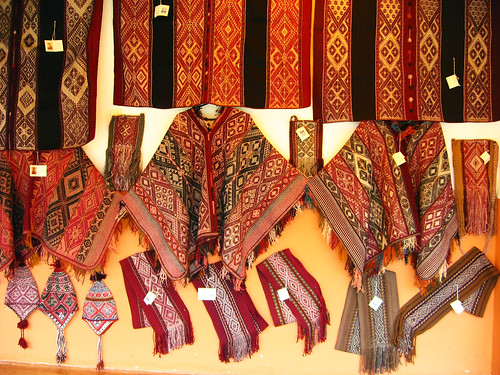The view on the way to Ica

Come to find out Adrienne had a “meeting” Saturday morning. Therefore I left without her (not waiting around an unknown amount of time). Headed to the bus station only to find out there were no buses for Paracas (and therefore Isla Ballestas) before 1pm, which means I didn’t get to go to the crazy island of the Pelicans and Blue Footed Boobies and Penguines……… I headed straight for Ica instead, a Pisco growing area on the edge of the desert. Ended up staying in a small Oasis town called Huacachina, with an honest to god lagoon surrounded by sand dunes, about 5min outside Ica.

First thing I did after getting a room at a hostel was head right back to Ica for an afternoon of adventure. First stop: Museo Regional de Ica! It’s a small regional archeology museum housing artifacts from Ica and the minor civilizations there, as well as Wari textiles, Nazca ceramics and textiles, and even some Inca textiles. I was in Heaven! Wari textiles really are as fine as everyone tells me and they were gorgeous!! This was also the first time I’d seen actual Quipus (supposed by archeologists to be a kind of Incan “written” language of knotted ropes). They had two, very exciting. I rounded the corner of the museum, thinking I was finished once the Inca section was done, and found a room full of “mummies!” Now, the interesting thing about mummies in Peru is they’re not actually mummies in the Egyptian sense (which is the official definition). They are bodies, usually sacrifices, that have been dried and preserved due to the climate of the regions where they’re found (they still have all their guts).

Along with the handful of mummies (more than one is A LOT), they had a collection of crazy shaped skulls due to the Incan belief that the elongated skull was beautiful… There was a diagram of how they did this and an actual preserved apparatus (kinda horrific actually) and I overheard the guide of another group say that every so often, during the process the head of the person might burst. Gross. And of course this was practiced by the rich and nobility, which makes me wonder why they’d put their children through this if the mortality rate was so high… I mean, they had such issues with heirs in Europe, you’d think the boys at least would be too precious for the risk?
Second Stop: Bodega el Catador, the oldest Pisco vineyard and winery in the region (over 200 years old).
Got to the Bodega el Catador, and played the “No hablo Espanol” card (because in all honesty, wine-making terms are not yet part of my Spanish vocabulary) and somehow ended up with the owner of the vineyard as my tour guide. It was totally cool! He told me he learned English while spending 14 years in Napa Valley, working with wineries there, before inheriting the family business from his father.

To make wine/Pisco, you must:
1. Stomp on the grapes (like with your feet)
2. Press the grapes (they have this gigantic wooden press, so cool)

3. Fill the crazy ceramic Inca jugs with the juice (each ceramic vessel weights 300kilos and holds 70L of wine)

4. Ferment the juice 15 days
5. Distill the fermented juice with wood-fire ovens (heat and boil, and if you want to flavor it, add your oranges/lemons here = very similar process to flavored Vodkas)

6. Condense the hot steam in this spirally pipe called “the works” (when making wine, it is submerged in water to help with rapid cooling)
7. Contain and store/age the now-wine in “the cave” (a dark, cool space, housing barrels)
8. Bottle
After the tour, a wine tasting! I learned that Pisco made with purple/black grapes is the kind used for Pisco Sours, and Pisco made with white grapes is usually served with no additions on the rocks (tastes like whiskey, mmm).
Ended up just having dinner at one of the restaurants at the winery (sometimes you just have to go with the touristy option to make sure your tummy doesn’t decide it disagrees) and ended up having a Peruvina “chili” called Carapulcra. It’s a broth-based spicy sauce with dried chili pepper, pulled pork, and yucca, usually eaten with Sopa Seco (spaghetti with pesto) and more yucca. Then a quick drink before heading back to my hostel (S./5 for a Pisco Sour? Yes please!) They make some seriously good Pisco at that vineyard. The bar tender turned out to be the oldest son of the owner of the vineyard, and we practiced our English/Spanish on each other (he’s now my friend on facebook, so when I’m a famous cook like Julia Child, I’ll have my own Pisco grower).











































